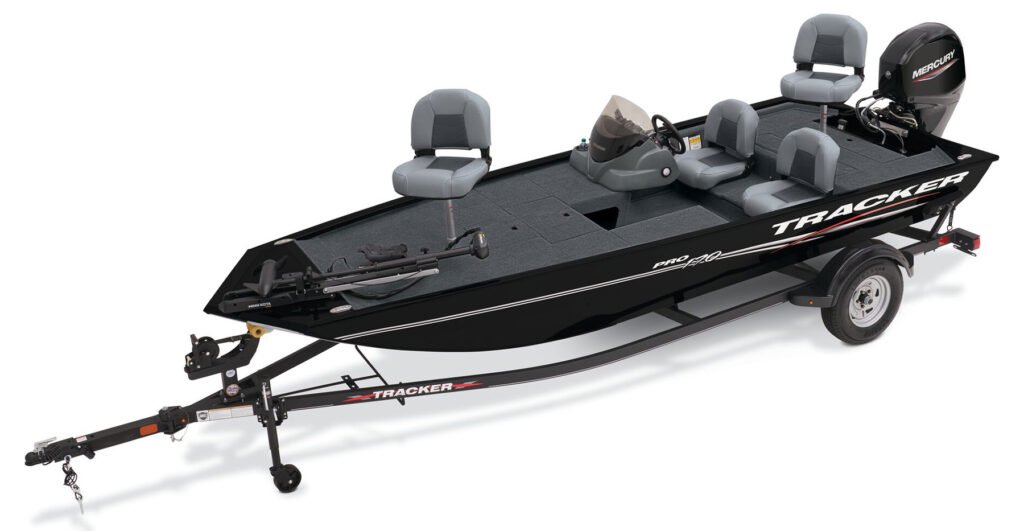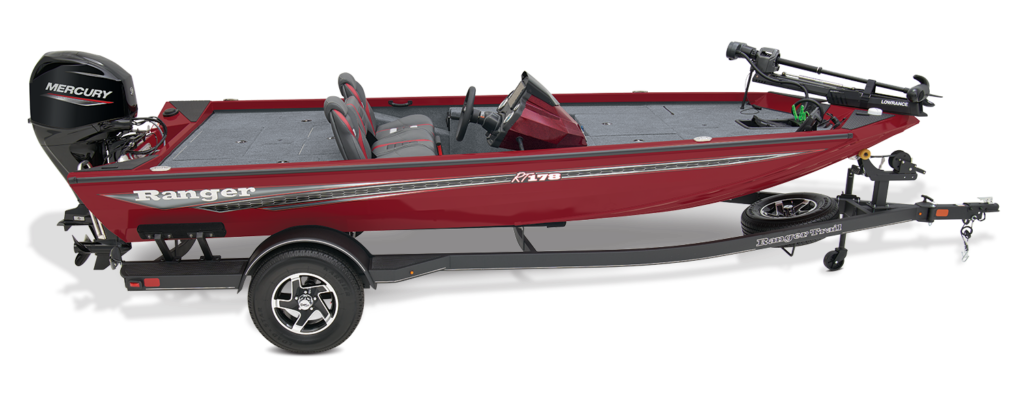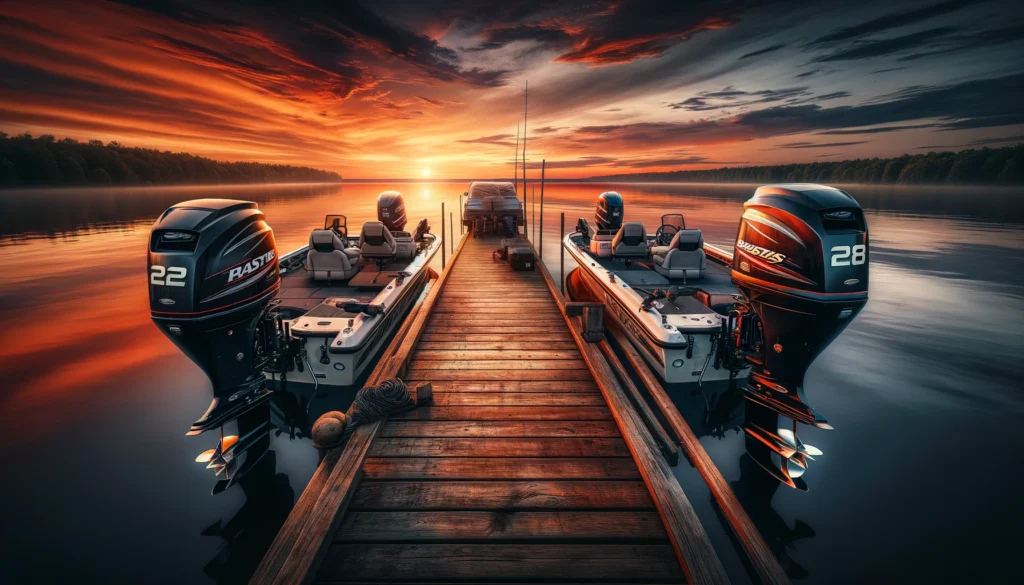Bass fishing ignites a passion for adventure and competition unlike any other. But for beginners, navigating the world of bass boats can feel overwhelming. Fear not, aspiring angler! This guide dives into the best bass boats for beginners in 2024, helping you choose the perfect vessel to launch your bass fishing journey.

Before we cast off and explore the top contenders, let’s take a moment to consider what makes a bass boat ideal for a beginner. Starter bass boats prioritize stability, disability, and affordability, unlike their high-powered tournament cousins. These features will make your early fishing experiences more enjoyable and less intimidating. Here are some key factors to keep in mind:
Size & Stability: A smaller, lighter boat (typically under 18 feet) offers better maneuverability and is easier to handle, especially for solo anglers. Stability is crucial for casting, fighting fish, and navigating choppy waters.
Features & Functionality: Look for features that enhance your fishing experience, like comfortable casting decks, live wells for keeping bait healthy, and ample rod storage. However, avoid getting overwhelmed by complex features you might not utilize initially. You don’t need to put an entire tackle shop in your boat.
Budget: Bass boats can range significantly in price. Set a realistic budget and prioritize essential features over those big ticket items. Remember, you can always upgrade later as your skills and needs evolve. But I highly recommend leaving enough money for that bass tracker, especially if you want to do any tournament fishing.
Considering these factors, you’ll be well-equipped to choose a bass boat that will set you up for success and fuel your passion for bass fishing. If you’re beginning your quest, visit our detailed buyer’s guide. Let’s reel in the top 5 bass boats perfect for launching your angling adventures in 2024!
The Top 5 Best Bass Boats for Beginners on the Market
1. Best for Budget: Lowe Stinger 17 SS

The Lowe Stinger 17 SS remains an excellent choice for beginners seeking a budget-friendly and stable bass boat. At just under 17 feet, it’s easy to maneuver and trailer. This feature-rich boat offers a spacious casting deck, comfortable seating, ample rod storage, and an aerated livewell to keep your bait fresh. The Lowe Stinger 17 SS is a great option for both freshwater and saltwater fishing, including rough water and big waves. It has a Minn Kota® Edge® 12V, 45-lb. (20.41 kg) thrust, 45″ (1.14 m) shaft, foot-control trolling motor. Read more here.
2. Best Value: Tracker Pro 170 Series

The Tracker Pro 170 Series offers excellent value for beginner bass boats. Available in multiple configurations with tiller or console steering options, it caters to your preference. Standard features include a livewell, lockable rod storage and comfortable seating. The Tracker Pro 170 Series provides a stable platform for casting and fighting fish, making it ideal for new anglers. Read more here.
3. Best All-Around: Nitro ZT 18

Stepping up slightly in size and power, the Nitro ZT 18 balances affordability and performance. This feature-packed bass boat boasts a spacious casting deck, a live well, comfortable seating, and ample storage compartments. It also comes equipped with a Mercury engine, ensuring reliable performance on the water. Read more here.
4. Best All-Weather Durability: Crestliner 1750 Sportfish
The Crestliner 1750 Sportfish is a versatile aluminum bass boat well-suited for beginners, especially those who prioritize durability. This feature-rich boat offers a comfortable ride, ample storage space, and a livewell. The Crestliner 1750 Sportfish is known for its ability to handle rougher waters, making it a great choice for all-weather fishing. Read more here.
5. Best for Compact Size, Ideal for Small Lakes: Ranger RT178

Don’t let its small size fool you; the Ranger RT178 is a bass resource that navigates small lakes and rivers. With its lightweight design and shallow draft, this boat can easily reach even the tightest fishing spots. Read more here.
Bonus: Best Tournament Boat: Bass Cat Puma STS
Its Jaguar is the envy of bass boats but performs best when it has an engine that is too big. The Puma has taken on a similar soft-touch design with a 250 horsepower hull, packaging it into a fast-burning product that passes the average boat at take-off but remains fuel efficient. Its main advantage is its wave killer and sports car characteristics, which allow it to withstand any water from narrow tidal streams through the Great Lakes. It’s equipped with recessed trolling motors that BassCat pioneered decades ago.

Buyer's Guide: Choosing a Bass Fishing Boat
When choosing a bass boat, one of the first things you should consider is the hull design. Different hull designs offer varying levels of performance and stability on the water. The most common hulls for bass boats are V-hull, modified V-hull, and flat-bottom.
The V-hull design is the most popular among anglers because it easily cuts through rough waters. This hull offers a smooth ride and excellent maneuverability, making it ideal for those who love fishing in larger lakes or venturing into coastal waters.
On the other hand, if you plan on mainly fishing in shallow lakes or rivers, a flat-bottomed bass boat might be more suitable as it has a shallower draft and allows you to navigate through shallow areas easily. For those who want the best of both worlds, a modified V-hull might be just what you need.
This hybrid design combines a stable flat bottom with a V-hull’s performance benefits. It provides better stability at rest while still offering good maneuverability when cruising or trolling.
Length and Width Considerations
The length and width of your bass boat are essential factors to consider as they directly impact its performance on the water. Generally speaking, longer boats provide better handling at higher speeds, smoother rides through choppy waters, and increased storage space for your fishing gear. However, longer boats may also require more power from your motor to perform optimally.
So, if you’re planning on fishing in smaller bodies of water or prefer slower speeds for a more relaxing experience, going for a shorter boat might be the right boat for you. Regarding width or beam measurements, wider boats offer enhanced stability while casting or standing up during intense battles with big bass monsters.
They also provide additional space for multiple anglers, which can be great if you often fish with friends or family. Conversely, narrower boats are more maneuverable and easier to handle in tight spots.
Weight Capacity and Storage Options
Another crucial consideration is the weight capacity of your bass boat. Choosing a boat that can comfortably accommodate you and your fishing gear without exceeding its limits is essential. Exceeding the weight capacity can negatively affect the boat’s performance, stability, and even safety on the water.
Storage options are also vital in keeping your boat gear organized and easily accessible during fishing trips. Look for boats with ample storage compartments, such as rod lockers, tackle boxes, and live wells. These features will ensure that all your essential equipment stays protected from damage while conveniently within reach when needed.
Finding the best bass boat for first-timers requires considering these key factors – hull design, length and width dimensions, weight capacity limitations, and storage options – to ensure that you make an informed decision tailored to your specific needs as an angler.
Key Features to Look for in Beginner Bass Boats
Outboard Motors: Two-stroke vs Four-stroke Engines
Two-stroke engines are known for their simplicity and lighter weight, making them popular among anglers. They provide quick acceleration, which can be advantageous when maneuvering through tight spaces or changing fishing spots frequently.
Four-stroke engines are renowned for their fuel efficiency and quieter operation. These engines offer a smoother ride, reducing vibrations that might scare away fish. While they may come with a higher initial cost, they tend to require less maintenance in the long run.

Trolling Motor: Bow-mounted vs. Transom-mounted
Trolling motors on a beginner bass boat offer two mounting options: bow-mounted or transom-mounted.
Bow-mounted trolling motors are attached at the front of the boat and provide excellent maneuverability and control. They allow you to move quietly through the water, like a light boat, and easily change direction while maintaining stability. This type of motor is ideal for anglers who prefer fishing from the front of the boat or in areas with heavy vegetation.
Transom-mounted trolling motors are attached at the rear of the boat and are often more affordable than their bow-mounted counterparts. They are easy to install and suitable for beginners who prioritize simplicity and budget-friendliness over advanced features. Transom-mounted motors work well in open waters where precision maneuvering is less critical.
Fish Finders and GPS Systems: Enhancing Fishing Experience
To maximize your chances of landing trophy-worthy catches as a beginner angler, consider equipping your bass boat with fish finders and GPS systems. Using sonar technology, fish finders detect underwater objects, including fish schools and structures. They display a graphical representation of the underwater environment, helping you identify potential hotspots and improve your fishing techniques.
Some models even provide detailed information about water temperature and depth. GPS systems, on the other hand, assist with navigation and allow you to mark your favorite fishing spots for future reference.
Using waypoints and tracking features, you can create a personalized map of successful fishing locations, ensuring you never miss out on a fruitful spot again. Additionally, GPS systems can aid in planning efficient routes and avoiding hazardous areas or shallow waters.
Exploring Different Materials Used in Bass Boats
Aluminum: Lightweight, Affordable, and Durable Option
Aluminum boats reign supreme regarding affordable bass boats that offer a great balance between performance and cost-effectiveness. Thanks to their lightweight nature, they are easy to maneuver both on and off the water.
Aluminum is known for its high durability, making it resistant to impacts from rocks or debris you might encounter while exploring those hidden fishing spots. Additionally, these boats require less maintenance compared to other materials.
Whether you’re a beginner or an experienced angler, an aluminum bass boat can provide a stable platform for casting your line without breaking the bank.
Fiberglass: Superior Performance, Sleek Design, Higher Cost
Fiberglass bass boats might be your ideal choice if you have a slightly higher budget and seek top-notch performance with a touch of elegance. These sleek vessels are designed with aerodynamics in mind, allowing them to glide smoothly through the water with minimal resistance.
The fiberglass construction offers unparalleled strength and rigidity while reducing noise and vibration during operation. While a fiberglass bass boat may come at a higher cost than an aluminum boat, they are cheaper than a glass boat.
Trailer Considerations for Easy Transporting
Single Axle vs Tandem Axle Trailers - Choosing the Right Trailer for Hassle-Free Hauling

Selecting the right trailer is crucial when transporting your first boat. Two popular options are single-axle and tandem-axle trailers. Single-axle trailers consist of a single set of wheels, while tandem-axle trailers have two wheels.
The key consideration here is stability. Single-axle trailers are lighter and more maneuverable, making them suitable for smaller boats and shorter distances. On the other hand, tandem axle trailers offer improved stability and weight distribution, making them a wise choice for larger boats and longer trips. Remember that tandem axle trailers may have a higher price tag than their single-axle counterparts.
Trailer Brakes: Surge Brakes vs Electric Brakes
Surge brakes operate through hydraulic pressure created by the tow vehicle’s forward motion pushing against a master cylinder in the trailer’s hitch coupler. This system provides proportional braking. As you slow down your tow vehicle, it applies equal braking force to all wheels of the bass boat trailer.
Electric brakes use an electric controller inside your tow vehicle to activate braking in sync with how much pressure you apply on your brake pedal.
While both systems can provide efficient stopping power when properly maintained and adjusted, electric brakes offer more control as they allow you to adjust braking intensity manually using a controller installed inside your tow vehicle’s cabin.
Safety Equipment Every Beginner Should Have on Their Bass Boat
Life Jackets: Types and Proper Fit
A life jacket is one of the most important equipment every new boat owner should have. Even if you consider yourself a strong swimmer, unexpected situations can arise on the water, and wearing a life jacket can be a lifesaver.
Different types of life jackets are available, including foam-filled, inflatable, and hybrid models. Foam-filled life jackets provide reliable buoyancy and are suitable for most anglers.
Inflatable life jackets offer convenience and freedom of movement but require regular maintenance to ensure proper functioning. Hybrid models combine foam flotation with an inflatable chamber for optimal comfort and safety.
No matter which type you choose, always make sure the life jacket fits snugly but comfortably. It should not be too loose or restrictive during your fishing adventures. And make sure you have enough on the boat to protect all patrons.

Fire Extinguishers: Understanding Classifications
Fire safety is vital when you’re out on the water in your bass boat. A fire extinguisher onboard can help prevent small fires from escalating into uncontrollable disasters.
Fire extinguishers are classified based on their suitability for different types of fires. The ABC classification is the most common classification system, which categorizes fire extinguishers into three classes: A, B, and C.
Class A fire extinguishers are designed to tackle fires involving ordinary combustible materials like wood or paper.
Class B extinguishers are effective against flammable liquids such as gasoline or oil spills that could occur while refueling your boat.
Class C extinguishers are designed for electrical fires that may arise from faulty wiring or malfunctioning electronic equipment onboard your bass boat.
First Aid Kits: Essential Supplies for Emergencies

Accidents happen when we least expect them, so it’s crucial to have a well-stocked first aid kit on your bass boat. A properly equipped first aid kit can help you handle minor injuries and provide immediate care until professional medical assistance is available.
Adhesive bandages, sterile gauze pads, antiseptic wipes, adhesive tape, scissors, tweezers, pain relievers, and any necessary personal medication are essential supplies to include in your kit. Additionally, it’s wise to have items like a CPR face mask and emergency contact information readily accessible.
A well-stocked first aid kit ensures you can promptly address minor injuries or medical concerns until professional help arrives. It’s essential to be prepared for unforeseen circumstances while enjoying your fishing adventures on stable and affordable bass boats designed for beginners.
More Information:
Lowe Stinger 17 SS
Specifications:
- Overall length: 17 ft 7 in (5.36 m)
- Beam: 90 in (228.60 cm)
- Chine width: 60 in (152.40 cm)
- Transom height: 20 in (50.80 cm)
- Hull gauge: .100 in (2.54 mm)
- Maximum side depth: 21 in (53.34 cm)
- Fuel capacity: 19 gal (71.92 l)
- Maximum weight capacity: 1,178 lb (534.33 kg)
- Max person weight: 650 lb (294.83 kg)
- Engine power max: 80 HP (59.66 kw)
- Hull shape: Modified Vee
- Hull material: Aluminum
Tracker Pro 170 Series
Comfort, Convenience, & Peace of Mind:
-
- TRACKER® PROMISE: Best factory warranty for aluminum boats
- Limited lifetime hull warranty
- NMMA® certified, exceeds safety and flotation standards
- Easy-fill EPA-compliant fuel tank
- Safety features: motor-stop lanyard, fire extinguisher, horn, paddle
- Bow & stern eyes, 4 cleats for secure docking
Livewell System
-
- 15-gal. aerated bow livewell with bait bucket holder
- 500 GPH aerator/fill pump
- Molded design for easy cleanup and catch protection
Trolling Motor
-
- Minn Kota® Edge® 12V, 45-lb. thrust trolling motor with foot control
- Thru-bolted mount for durability
Console
-
- New Garmin® STRIKER™ 4 fishfinder with CHIRP transducer & GPS
- Sport steering wheel, no-feedback rotary steering
- Features: 1-piece console, tinted windscreen, storage, drink holder, 12V outlet, phone holder
- Speedometer, tachometer, fuel gauge, Mercury® control box
Interior
-
- Elevated casting decks, lockable storage
- 2 pedestal seats, 2 folding fishing seats
- 100% composite seats, port lockable rod box
- VERSATRACK® accessory-mounting channel
- Marine-grade carpet, interior with Dark Gray tones
Exterior
-
- Pressed-in keel & strakes, factory-matched propeller
- DIAMOND COAT™ finish in Starlite Red or TRACKER® Black
Construction & Performance:
-
- All-welded aluminum hull, .100 gauge
- Robotic welds, structural stringers, foam injected hull
- Pressure-treated floors, all-aluminum, carpeted lids
Electrical
-
- 800 GPH bilge pump, stowable navigation lights
- Bow & console lights, 2 battery trays
- Wiring in protective conduit
Trailer
-
- Custom-fit, single-axle trailer with GALVASHIELD® Impact protection
- Features: swing-away tongue, locking jack, winch, motor support, load guides, carpeted bunks, submersible LED lighting, tie-down straps, safety cables




